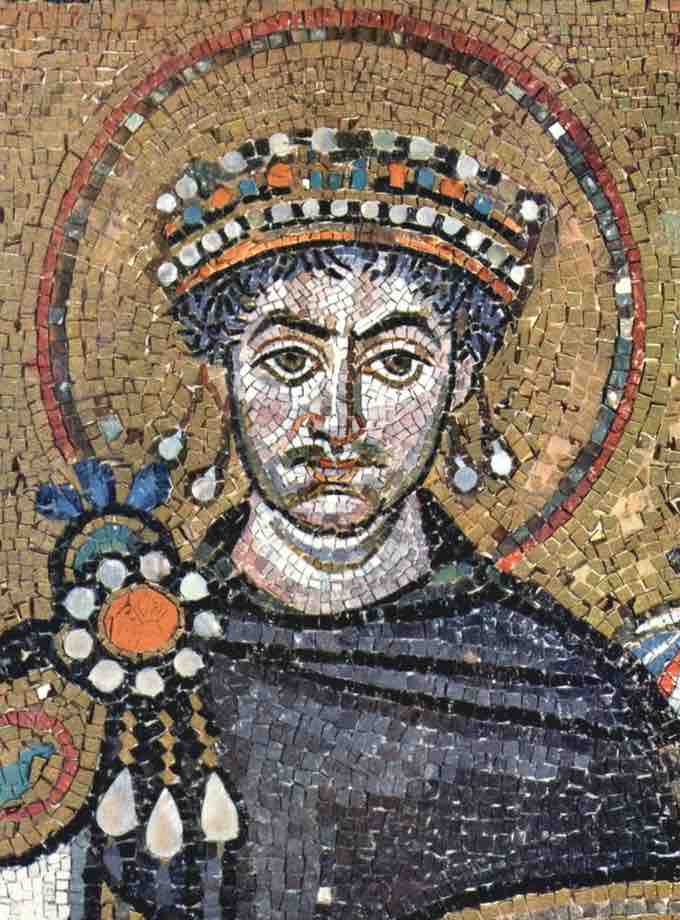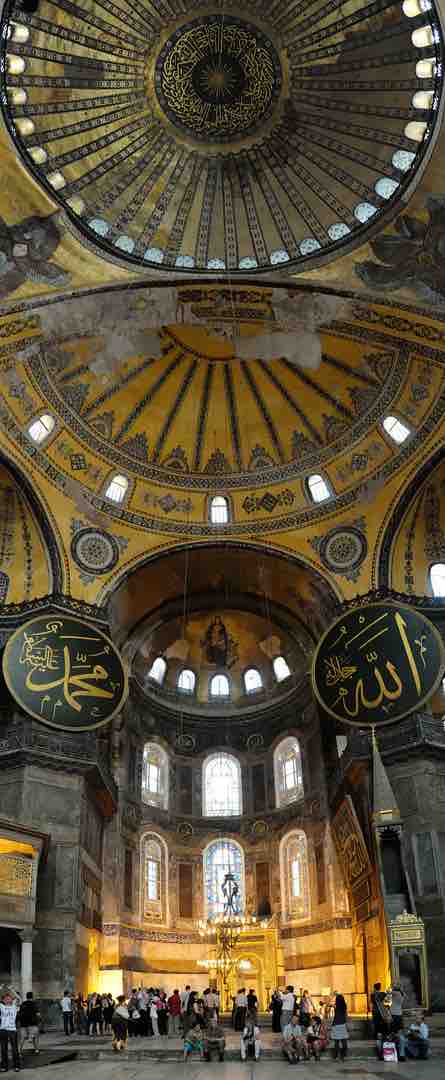Justinian I devoted much of his reign (527-565 CE) to reconquering Italy, North Africa, and Spain. During his reign, he sought to revive the empire's greatness and reconquer the lost western half of the historical Roman Empire. This attempt at restoration included an ambitious building program in Constantinople and elsewhere in the empire, by far the most substantial architectural achievement by one person in history.

Justinian I from San Vitale in Ravenna
Byzantine Emperor Justinian forcefully pushed for the spread of Christianity along with the expansion of his empire.
Hagia Sophia
One notable structure for which Justinian was responsible was the Hagia Sophia, or Church of Holy Wisdom, built by Isidorus of Miletus and Anthemius of Tralles, both of whom would oversee most building projects that Justinian ordered within Constantinople. Like most Byzantine churches of this time, the Hagia Sophia is centrally-planned, with the dome serving as its focal point.
Isidorus of Miletus and Anthemius of Tralles. Hagia Sophia, plan
a) Plan of the gallery (upper half); b) Plan of the ground floor (lower half)
The vast interior has a complex structure. The nave is covered by a central dome which at its maximum is over 180 feet from floor level and rests on an arcade of 40 arched windows. Although the dome appears circular at first glance, repairs to its structure have left it somewhat elliptical, with the diameter varying between 101 and nearly 103 feet.

Isidorus of Miletus and Anthemius of Tralles. Interior View of Hagia Sophia
Emperor Justinian ordered the construction of Hagia Sophia in 532 CE.
The dome of Hagia Sophia has spurred particular interest for many art historians, architects and engineers because of the innovative way the original architects envisioned it. The cupola is carried on four spherical triangular pendentives, an element which was first fully realized in this building. The pendentives implement the transition from the circular base of the dome to the rectangular base below, restraining the lateral forces of the dome and allow its weight to flow downwards. They were later reinforced with buttresses.
At the western entrance side and eastern liturgical side are arched openings extended by half domes of identical diameter to the central dome, carried on smaller semi-domed exedras. A hierarchy of dome-headed elements built to create a vast oblong interior crowned by the central dome, with a span of 250 feet.
The Imperial Gate, reserved only for the emperor, was the main entrance of the cathedral. A long ramp from the northern part of the outer narthex leads up to the upper gallery, which was traditionally reserved for the empress and her entourage. It is laid out in a horseshoe shape that encloses the nave until it reaches the apse. After the Ottoman conquest of Constantinople, the plan of the Hagia Sophia would significantly influence the construction and design of the Süleymaniye Mosque (1550-1557).
Elsewhere in Constantinople
The Church of the Holy Apostles, originally built under the purview of Constantine in 330, was no longer considered grand enough when Justinian ascended the throne. Because of this, the architects Isidorus of Miletus and Anthemius of Tralles designed and built a new church on the same site in the late 540s (consecrated in 550). Like the original church, Justinian's replacement had a cruciform plan and and was surmounted by five domes: one above each arm of the cross and one above the central bay where the arms intersected. The western arm of the cross extended farther than the others, forming an atrium. Because blueprints did not exist yet, and because the church was demolished shortly after the Ottoman conquest, the design details of the building are a matter of dispute.
The Church of Saints Sergius and Bacchus (527-536), known today as "Little Hagia Sophia," was probably a model for the actual Hagia Sophia. It was recognized at the time as an adornment to all of Constantinople. During the reign of Justinian's uncle Justin I, the future emperor faced accusations of conspiring against the current emperor and was killed for it. However, the Saints Sergius and Bacchus were said to have intervened, vouching to Justin that his nephew was innocent. After the restoration of his title, Justinian commissioned Isidorus of Miletus and Anthemius of Tralles to construct the church as a gesture of thanksgiving. When the church was built, it shared its narthex, atrium and propylaea with another church. It became one of the most important religious structures in Constantinople.
Isidorus of Miletus and Anthemius of Tralles. Little Hagia Sophia
General view of the interior, looking south and west.